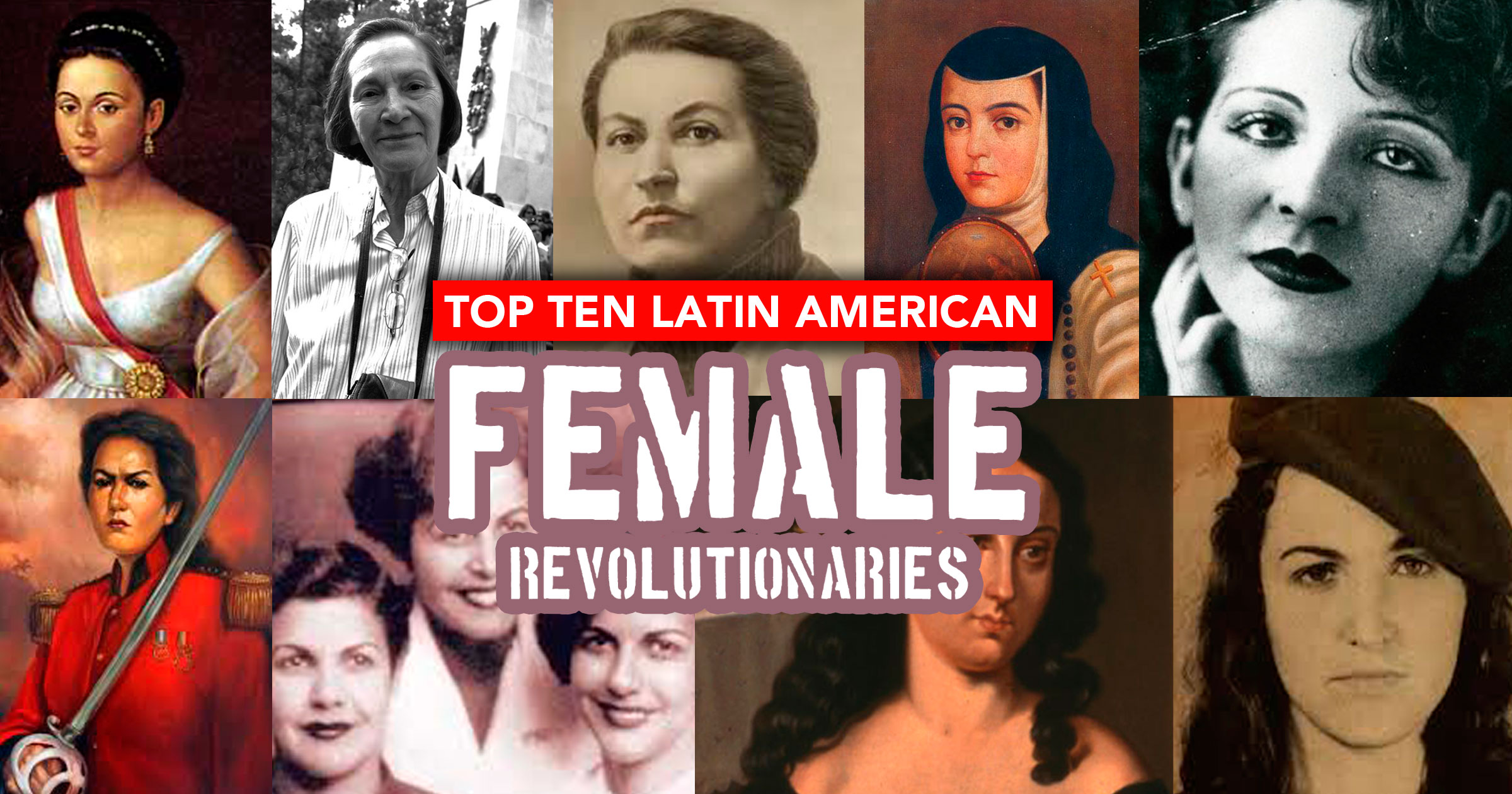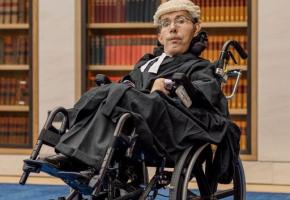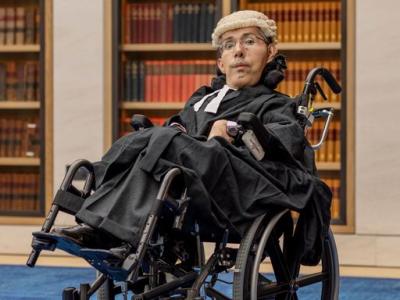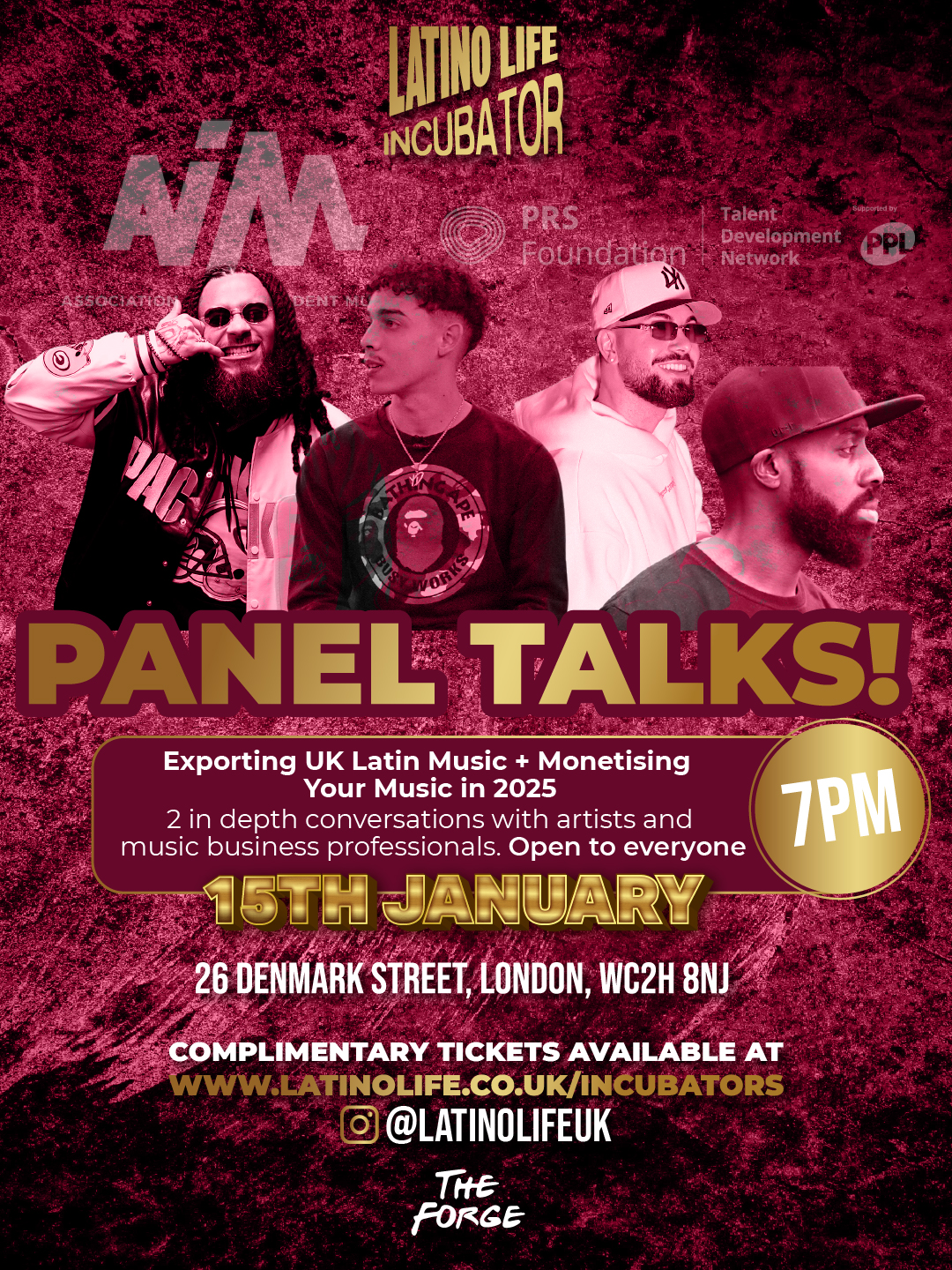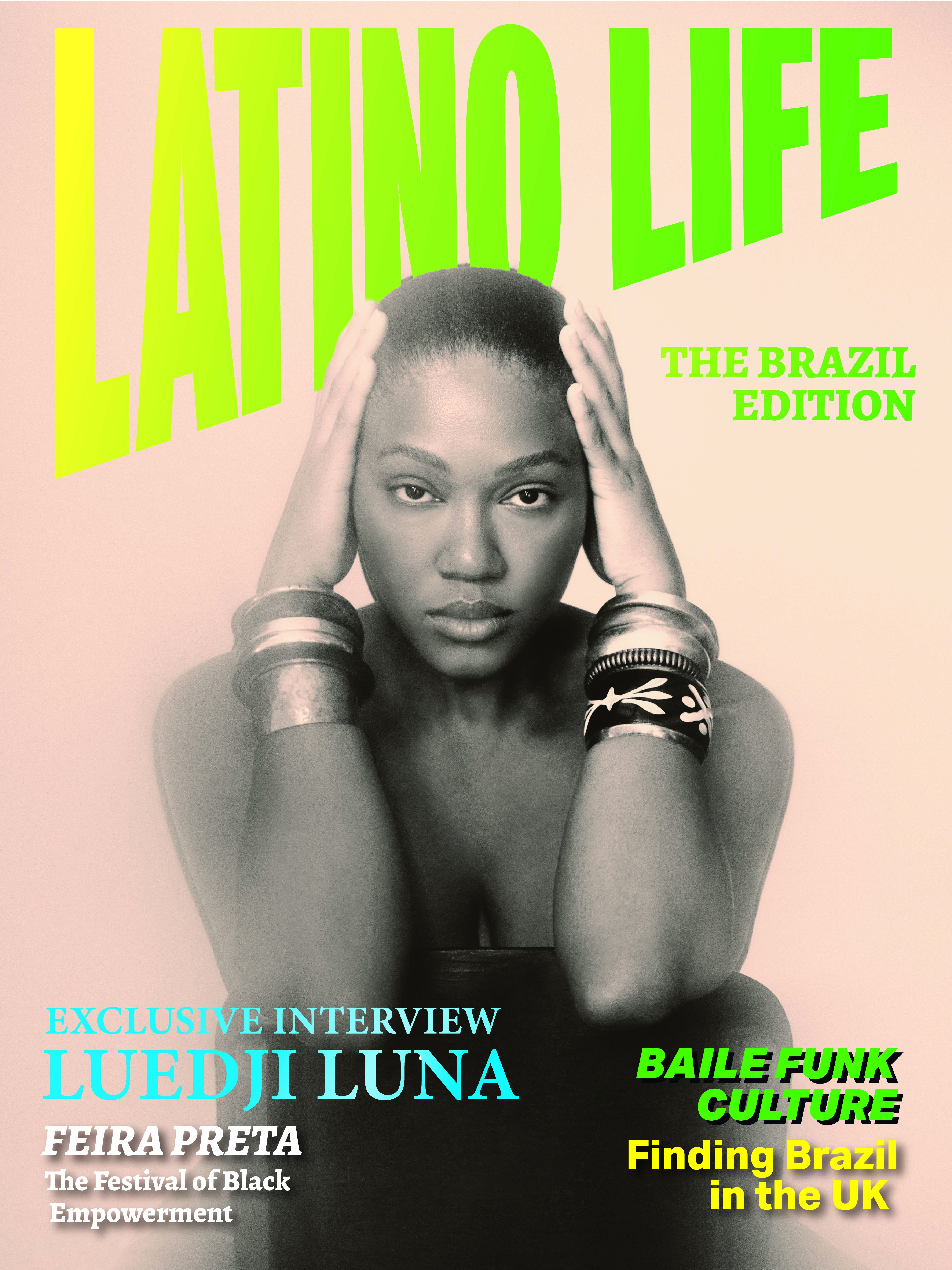1. Sor Juana Inés de la Cruz
Sor Juana Inés de la Cruz was born in New Spain (now Mexico) in 1648. She was a self-taught scholar, Latin America’s first great poet, prolific writer, philosopher, composer, and astronomer.
She joined the Hieronymite order in 1667 because then being a nun was the only way for a woman to lead an intellectual life. In her cell she received the most serious thinkers of the day, contributing to the political and cultural discourse of the Spanish Golden Age, and the Baroque literary movement. Her poetry addressed spirituality and love, and openly criticized the misogyny and hypocrisy of men: one of her most famous poems is “Foolish Men.
Her chosen life made her an early proponent of a feminist platform i.e. a woman’s right to study. And although she had the ear of the Spanish Viceroy, Antonio Sebastián de Toledo, through his wife who became a confidante, she was constantly criticized by Mexico City’s conservative colonial society and her rights were always at risk.
She also faced the approbium of the Church. The Bishop of Puebla condemned her radical thinking and eventually forced her to sell her book collection and astronomical instruments, and turn her focus instead to charitable works.
Sor Juana died in 1695, catching the plague while treating her sister. Posthumously her work gained in importance and nowadays scholars interpret Sor Juana as a proto-feminist, a leader in themes such as colonialism, education rights, women’s religious authority, and her writing as examples of feminist advocacy. She has earned epithets like the “Tenth Muse” and “Phoenix of Mexico”.
Other facts: A biography of her was written by Mexican cultural icon Octavio Paz in 1982; A feature film “Sor Juana de la Cruz” was directed by María Luis Bemberg in 1990; Her birthplace changed name from San Miguel Nepantla to Nepantla Sor Juana de la Cruz; San Jerónimo Convent where she live was renamed Sor Juana de la Cruz University in1977
2. Manuela ‘Manuelita’ Sáenz
Manuela Sáenz is a feminist symbol of the 19th century South American wars of Independence. She became known as ‘The Liberator of the Liberator’; a reference to her 20-year romance with Simón Bolivar, but she played an important part in the Independence movement herself.
Manuela Sáenz de Vergara y Aizpuru was born in Quito, Viceroyalty of New Granada (now Ecuador) in 1797. Although born out of wedlock, Manuelita was convent-educated and acquired social graces from her Spanish father, who to curb her rebellious spirit, married her to a wealthy English merchant James Thorne. In 1819, The couple moved to Lima, Peru, in 1820 where she held high society gatherings in her home. Guests included political leaders and military officers who shared secrets about the ongoing revolution, unaware that Manuelita was an active member of resistance to Spanish rule.
In 1822 Manuela met Bolívar through her friend Rosita Campusano, mistress of José San Martín, liberator of Latin America’s southern cone. She fell in love but her affair with Bolívar might have been short-lived had it not been for the fact that love and revolutionary ambition coincided, and Manuela left her husband to actively pursue the general. She did political work for him, distributing leaflets, gathering information: in fact her undercover spying twice saved his life, notably in 1828 during the ‘September Conspiracy’. But she also followed him to the battlefield, nursed him and other wounded officers, shared his visión and even gave him advice. General Sucre called her participation in the battles of Junín and Ayacucho ‘heroic’ and made her an honorary Colonel: she often dressed in military uniform.
Manuelita stayed with Bolívar until his death from tuberculosis in Santa Marta, Colombia, in 1830. By then his military successes were famous but his political dreams of a Greater Colombia were in tatters. She was exiled to Jamaica by Bolívar’s political rival Santander. She wanted to continue her political work in her native Ecuador but her association with Bolívar’s now discredited political dream led the then president, Vicente Rocafuerte, to revoke her passport. Manuelita sought refuge in Peru and spend her time writing letters to important people about the role of women, to no avail. Disabled and poverty-stricken, she died in 1856 during a diphtheria epidemic and was buried in a common grave, her belongings burned.
Manuelita had been a revolutionary life force, but she faded from history between 1860 and 1940, except for references to her as Bolívar’s lover. However, as the twentieth century progressed, attitudes to women changed so did interest in nationalism. Enough of her letters to Bolívar survived, together with his archive, for her role in the Independence struggle to be re-assessed:
Other facts: In the 1980s, she was a common rallying point for feminist and Indo-Latina causes; “The General in his Labrynth” by Gabriel García Marquéz, humanized and politicized her; “Manuela Sáenz, la Libertadora del Libertador” by Alfonso Rumazo restored her pan-nationalist image; Hugo Chavez gave her a symbolic burial next to Bolívar’s remains in the Pantheon of Venezuela in 2010;The Ecuadorian government symbolically gave Saenz the rank of General in 2007
3. Juana Azurduy de Padilla
Born in 1780, Juana Azurduy de Padilla was a guerrilla leader from Chuquisaca, Viceroyalty of the Río de la Plata (now Sucre, the capital of Bolivia). She fought for independence from Spanish rule and the rights of the indigenous people of Upper Peru. Of mixed heritage, she spoke Quechua and Aymara as well as Spanish
In 1809, Azurduy and her husband joined the Chuquisaca Revolution which ousted the Spanish governor of the Reál Audencia of Charcas and established a governing Junta de Buenos Aires. In the years that followed, she continued to fight Spanish royalist tropos, helping General Manuel Belgrano, Commander of the Independence Movement’s northern army, to recruit troops. A tremendous recruiting force among the indigenous population, she led the ‘Loyal Battalions’, named for their fierce loyalty to their commander. She even inspired a batallion of women who became known as ‘Amazonas’. At the height of her power, she led an army of 6,000 soldiers.
Juana was granted a Colonel’s military pension in 1825 by Simón Bolívar, first president of newly independent Gran Colombia (which then included Bolivia). Unfortunately it was revoked in 1857 in the so-called bureaucratic organization of the government of José María Linares and in 1862 she died penniless, at the age of 82. She was buried in a common grave.
Other facts: A hundred years later her remains were exhumed and moved to a mausoleum built in her honour in the city of Sucre. When Evo Morales was elected President, he declared her birthday - July 12 - the Day of Argentine-Bolivian Friendship. A province of Bolivia is now named after her, as is the airport at Sucre.
4. Policarpa ‘La Pola’ Salavarrieta
Policarpa Salavarrieta was born in 1795 to a well-off Creole family in the small town of Guaduas, Viceroyalty of New Granada (now Colombia). In 1810, she moved with her brothers to Bogotá where as ‘La Pola’ she became a key figure in the movement for Independence from Spain. She used her skills as a 5.seamstress to gain access to Spanish royalist families, and passed on political information she overheard in their households to the underground resistance. She also helped forge documents.
When the Spanish authorities discovered La Pola’s role as a spy, she and six other prisoners were sentenced to death by the Council of War. Execution was set for the morning of November 14, 1817. When ordered to turn round and kneel, the way traitors were normally shot, she refused. Facing the firing squad, she cried defiantly “I have more than enough courage to suffer this death and a thousand more”. She called on people to revenge her death, and the response to her public execution triggered her legend as a Latin American resistance heroine. She was one of 50 female agents to be executed before Colombia achieved independence in 1819.
Other facts: 150 years later, the Colombian Congress declared November 14 “Colombian Women’s Day” to commemorate La Pola’s death. She was the first Latin American woman to appear on a postage stamp. Her face was also on a 1977 two-peso Colombian banknote.
5. Patricia Galvao (known as Paixão Pagu)
Pagu was a Brazilian artist, writer, journalist, and militant revolutionary. Born in 1910 into a bourgeois family of German descent, she moved away from her class and in 1930 joined the Brazilian Communist Party.
As an activist in the workers’ struggle, she was imprisoned 23 times. Her three-year stint in jail for taking part in a dockers strike in the port city of Santos in 1930 earned her the title ‘Brazil’s first female political prisoner’. Her arrest and torture by the forces of the Getulio Vargas dictatorship in 1935 resulted in her longest stay in prison: five years.
As a writer, she was best known for the novel “Parque Industrial”. Published in 1933 under the pseudonyn Mara Lobo, it was considered the first Brazilian proletarian novel. In it she describes the economic exploitation of the poor in order to feed the ‘Capitalist monster’, the atrocious working conditions in Sao Paulo, and the sexual exploitation of women.
She was also an early feminist, dressing flamboyantly, smoking, swearing,and generally challenging female social stereotypes. She joined Sao Paulo’s anthropophagic movement and shocked even them by marrying its (already-married) protagonist Oswald de Andrade indecently quickly.
After publishing ‘Industrial Park’, she travelled abroad as a newspaper reporter, but got into trouble in Paris when she was arrested (again) for being a ‘foreign communist with false papers’ and only released on the intervention of the Brazilian Ambassador.
After her five years in prison, she moved closer to Trotskyism and in 1940 left the Communist Party, criticizing it for supporting the bureaucratization of the Russian Revolution. She wrote for ‘Vanguardia Socialista’ and married fellow journalist Geraldo Ferraz with whom she wrote the novel ‘A Famosa Revista’ in 1945. When politics opened up in the 1950s, she unsuccessfully ran for state office. However, she continued her artistic life in the city of Santos, turning to Avant-garde theatre for inspiration: directing, criticism, translating, and inspiring young artists, until she died of cancer in 1962, at the age of 52.
Colourful, committed, courageous, Pagu was a true revolutionary figure in the political, cultural and feminist Brazil of the first half of the nineteenth century
6. Las hermanas Mirabal
Three sisters known as “Las Hermanas Mirabal” were involved in the revolutionary struggle against the dictator Rafael Trujillo in the Dominican Republic from 1930 to 1961. They were assassinated in 1960.
Patria, Minerva and María Teresa Mirabal, born respectively in 1936, 1934, and 1935, came from a land owning family in the Cibao región of centr Dominican Republic. They were convent educated, and as university students joined a clandestine group called the “14th June Movement”. They distributed pamphlets about Trujillo’s victims and stored munitions to be used when there was open revolt.
The sisters called themselves ‘Las Mariposas’ (‘Butterflies’) after the clandestinine nom de guerre of Minerva who, influenced by her uncle, was the most political, radical and vocal. As a law student, she was personally harrassed by Trujillo who then refused her a licence to practice law after she graduated. She was followed into the revolution by the youngest sister, María Teresa, a mathmatics student at the time. Both were imprisoned in 1960 but released when the Organization of American States sent observers and international opposition to Trujillo’s excesses was growing.
Their husbands, however, remained in jail and it was while on their way to visit them in Santo Domingo’s La Victoria prison on November 25, 1960, that Patria, Minerva, María Teresa were killed. Their car was intercept, they were clubbed and strangled to death, then their bodies piled into a jeep to make it look like a traffic accident. After Trujillo’s death on May 30, 1961, General Pupo Román admitted to personal knowledge that the sisters were assassinated by the dictator’s right-hand man, Víctor Peña Rivera.
Other facts: The sisters’ brutal murder made them symbols of popular and feminist resistance, both nationally and internationally. Honours have been heaped on them over the years: The United Nations General Assembly designated November 25 ‘International Day for the Elimination of Violence Against Women’ in 1999; Their eldest sister Dédé, who had not actively joined the struggle brought up their children on the family farm in Ojo de Agua where she created a Foundation and Museum; A mural depicting them adorns the seafront in Santo Domingo; A myriad of songs, poems, biographies, and plant names has been dedicated to them; A 1994 novel called “In the time of the Butterflies” by Julia Álvarez was later made into a film by Mariano Barroso; A Dominican Republic state and a Santo Domingo metro station is named after them; Their image was printed on a Dominican 200 peso bank note in 2007
7. Tamara Bunke aka Tania La Guerrillera
Haydée Tamara Bunke was born in Argentina in 1933 into a German Jewish family fleeing Nazism. Shr returned to East Germany when she was 14. Brought up a Communist, she later played an active role in Cuba after the Cuban Revolution.
In 1960, at the age of 23, Tamara met Che Guevara when interpreting for him on a Cuban trade visit to Leipzig. She told him she longed to return to Latin America. She moved to Cuba in 1961 where she first did solidarity work for the literacy campaign,; and building homes and schools in the countryside.. She then got paid work as a translator in the Ministry of Education and the Federation of Cuban Women, before finally joining Che’s programme of revolution for Latin American, training in espionaje and covert actions. She was given the nom de guerre Tania.
Years before Che left Cuba for his Bolivia campaign in 1967, he embedded Tania as a spy in the Bolivian political elite and military circles. Posing as a right-wing Argentine ethnologist, she became popular in La Paz high society. In 1965, she married a young Bolivian engineer. Using equipment hidden in a compartment behind the wall in her flat, she sent coded messages to Fidel Castro in La Havana and to the guerrilla base Che set up in the Chaco región of southern Bolivia. Che also sent her on missions to other Latin American countries to get support.
In 1968, Tania left La Paz to join Che in the armed struggle at his camp in Nancahuazú. By then, Che had lost radio contact with the outside world and the Bolivian army had discovered the guerillas whereabouts.. They withdraw to higher mountains in two columns which subsequently lost contact with each other. Tania was with the lead column. It was ambushed while crossing the Rio Grande river at Vado del Yeso. The river was swollen with heavy rains and Tania was apparently waist-deep in water when she was shot through the arm and lung. Eight of her fellow insurgents were killed in the ambush. Che was eventually captured and killed at La Higuera on October 8, 1968.
In 1998, Tania’s remains were traced to an unmarked grave on the periphery of a Bolivian army base in Vallegrande. The Cubans later built a memorial there to her and the other guerrillas who died in Bolivia. But her remains were transferred to Cuba and interred in the Che Guevara Mausoleum in Santa Clara, alongside those of Che himself. A contraversial figure, Tania conforms to the ideal of an international revolutionary: born in Argentina to German parents, an icon of the Cuban Revolution, who died fighting in Bolivia to liberate all of Latin America.
Other facts: When Fidel Castro learned of her death, he officially declared her ‘Tania, La Guerrillera’, a hero of the Cuban Revolution. The Venezuelan singer Ali Primera wrote a song about her. She has had books, poems and films made about her, youth clubs dedicated to her, and a star named after her.
8. Rigoberta Menchú Tum
Rigoberta Menchú’s book describing Mayan culture and the atrocities inflicted on the Mayan people during Guatemala’s Civil War (1960-1996) is included in Latinolife’s 10 Best Works of Non-Fiction. However, she is also included in this list for her lifetime of political activism and fighter for indigenous and womens’ rights.
Rigoberta was born in Chimel, in the Ixil triangle, a mountainous jungle área in northern Guatemala in 1959. Her family were peasants: her father active in the struggle for land and workers rights, and her mother a midwife involved in the social struggle. She followed in their footsteps, campaiging with the Committee for Peasant Union (CUC) and Catholic liberation theology priests. Politically, she supported the resistance line of the Guatemalan National Revolutionary Unity (UNRG). After both her parents and two brothers met horrific deaths at the hands of the Guatemalan army and her village was destroyed, she went into hiding, then fled to exile in Mexico in 1981 . .
In her decade in exile in the 1980s, she campaigned tirelesssly against human rights violations in Guatemala, and organized at the UN on indigenous isssues, visiting indigenous peoples in SE Asia, US/Canada and Latin America. She was awarded the Nobel Peace Prize for this work in 1992, being then the youngest and first indigenous prizewinner. The same year she was an appointed goodwill ambassador by UNESCO.
After the Civil War ended in 1996, Rigoberta returned to Guatemala and created the Rigoberta Menchú Foundation. It campaigned to get former President Rios Montt tried for war crimes in Spanish courts: prosecutions in Guatemala being virtually impossible then. Spain called for his extradition in 2006 but, after losing his parliamentary immunity, Rios Montt was eventually convicted of genocide and crimes against humanity in a Guatemalan court in 2012, receiving two life sentences.
In the past two decades the Menchú Foundation has also campaigned to exhume mass graves, legislate for new crimes, fight for the return of ancestral Mayan lands, and has documented 36,000 Mayan women.
In 2007 Menchú formed a political party called Winaq (People), the first indigenous party in Central America, and ran for president. She did not win (nor did she in 2011) but set a precedent as the first Mayan and first woman to do so. Winaq has one Mayan MP which she considers a great victory.
“When the Mountains Tremble” a film of the Mayan participation in the Civil War, directed by Newton Thomas Siegel, won the Special Jury Prize at Sundance in 1983
9. Madres de la Plaza de Mayo (Mothers of May Square)
Argentina’s ‘Dirty War’ created a new category of war victims, that of Los Desaparicidos (the Disappeared). These opponents of the 1976-1983 Argentine military junta were not killed in battle, assassinated or imprisoned. They were simply people (30,000 of them) who disappeared without trace. Some were Marxist or Peronist guerrillas fighting the military but most were schoolkids, university students, factory workers, trades unionists, left-wing professionals, volunteers in shanty towns; anyone who held views suspected of being ‘subversive’.
Families lost members of all ages, but most of the Disappeared were between 17 and 27 years old.
In response to this phenomenon, Azucena Villaflor, a working class housewife from Buenos Aires, founded a unique organization. On 13 April, 1977, she and 13 other mothers she’d met on their cruel search round pólice stations and jails, stood silently facing the Presidential Palace wearing white headscarves and holding photos of their disappeared children. The police moved them on, so they walked in a circle. ‘Las Madres de la Plaza d Mayo’ was born.
Under dictatorship surveillance, progress was slow, threatened by the disappearance of Azucena herself later that year. Nevertheless, more brave, desperate mothers kept joining and the few turned into the many.. With help from foreign ngos, data bases were created of sightings in clandestine prisons and a profile of the represión emerged. When Argentina returned to democracy in 1983, this information helped President Alfonsín’s Truth Commision to sentence nine junta members to life imprisonment.
Unfortunately, despite their slogan “You took them alive,we want them back alive”, few of the children reappeared. Searching for their remains became the next task. This was hindered by the junta’s policy of disappearing corpses as well. The bodies of victims killed in the Army’s Campo de Mayo base, the Navy Mechanic’s School (ESMA) or in the hundreds of clandestine torture centres around Argentina, were thrown out of planes into the sea. Fortunately for identification purposes, they later washed up in the River Plate estuary or on beaches of the Atlantic coast. Mass graves were also gradually unearthed, and through improved forensic techniques thousands of victims were eventually identified.
Yet after decades of work, hope and grief, the Mothers still had to fight for justice. Changes of governments meant the junta members were first released in 1985, then pardoned in 1990. Only when the Kirschner government came to power in 2003 were the Amnesty Laws derogated. Only then could law suits be brought against their childrens’ torturers.
The Mothers’ still campaign for human rights. Their legacy are the many organizations that have mushroomed all over Latin America and on other continents, where the revolutionary white handkerchief as a symbol of hope and peace.
10. Las Abuelas de la Plaza de Mayo
In 1977, Chichi Mariani, one of the ‘Mothers of the Plaza de Mayo’,suggested that an equally unique organization called the ‘Grandmothers of the Plaza de Mayo’ be created to address another cruel phenomenon.
Some of their daughters had been abducted with small children, or had been pregnant, or were impregnated by their torturers. The children or the babies born in captivity were known to have been adopted by military families or others who could be relied upon to bring them up in the ‘right’ way. A genetic data base called The Grandparents Index with the details of over 500 disappeared grandchildren was created in 1978, and eventually, with the advances in DNA science, included a bank where samples could be stored. It was the first of it’s kind in the world. After painstaking investigation, grandchildren began to be found. Some of the stories behind the sleuthing were astonishing.
At first it was the grandmothers who did detective work . But over the decades, helped by the Grandmothers Index and the publicity about ‘found’ children, youngsters who for one reason or another felt uncomfortable at home.could deposit blood or look at the photo database. If they found women who looked like them, a DNA match could prove it.
The Grandmothers’ goal was to find the adopted children and restore them to what was left of their birth familes. But reactions varied. Some children were happy to accept their dead parents’ families, and sometimes changed their names back. Others refused to take the test, or were forbidden to by their adoptive parents. Some were happy with the only parents they’d ever known, but acknowledged the pain of their birth family. In contested cases, the law had to intervene, as in the notorious case of the children of the owner of the newspaper group Clarín.*
One thing in the Grandmothers’ favour was that a loophole in the Amnesty Laws did not cover theft of babies, and it was possible to prosecute both the intellectual authors of the crime, and the complicit adopters. Several army officers were found guilty and jailed; moreso after the prorogation of the laws.
Time is not on the Grandmother’s side, all are in their 80s. Chicha Mariani, their first president, died without finding her granddaughter. But the second president Estela de Carlota found her grandson in 2014 after 34 years of searching: the 114th grandchild to be found. The figure now is 127.


